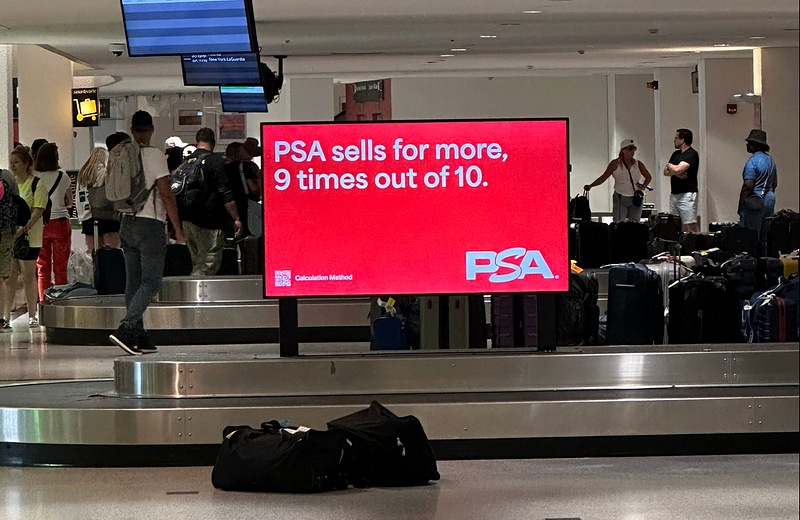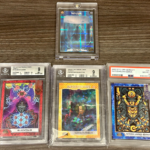August 8, 2024
When you have the chance to harness information to your advantage, it’s wise to seize it. The trading card community understood this well, leading to the establishment of the first trading card grading service by Professional Sports Authenticator (PSA) in 1991.
Today, PSA is the industry benchmark, grading over 10 million cards annually. With fees ranging from $25 per card (excluding Collector’s Club membership benefits) to $10,000 for a single card, PSA runs a highly profitable operation. Their value proposition to consumers is unmistakably clear.

As new members join the trading card community and deepen their understanding of The Hobby, it’s a great time to understand the world of trading card grading.
In this blog, I explore various aspects of grading and establish a benchmark for the population and grade distribution of a new trading card project — Bitcoin Trading Cards (BTCTC). As of August 6, 2024, BTCTC has graded a small but notable sample of over 500 cards from its limited sets. By analyzing the grade distribution, we can gain insights into the future trends and what collectors will be seeking in the years ahead.
- Grading Scales and Criteria: Common standards for evaluating cards.
- Grading Companies: Key players and new entrants.
- Impact on Card Value: Secondary market implications.
- Submission Process: Turnaround times, shipping, and on-site options.
- Challenges and Controversies: Subjectivity, counterfeiting, and more.
- Tips for Collectors: Preparing cards and choosing a service.
- Future of Grading: Trends, innovations, and predictions.
- Dive into BTCTC Grades: Populations, grade distributions, and market.
Every trading card company aspires to reach the milestone when their community gains access to the grading world. Achieving this requires time, patience, dedication, the collaboration of multiple parties, and a solid product. For BTCTC, this momentous occasion came on November 20, 2023, nearly one year to the date after the project’s launch. As the industry leader, PSA played a pivotal role, and Crain, the dedicated community member spearheading the effort, was the first to share the exciting news.
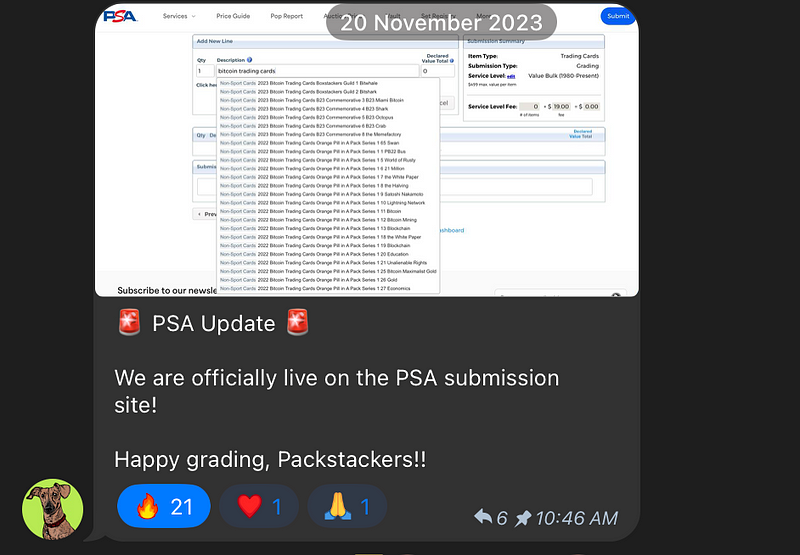
For those interested, Crain, an experienced trading card collector, has shared valuable tips for submitting cards for grading, which you can find later in the blog.
1. Introduction to Grading: Scale and Criteria
Grading in trading cards involves evaluating and assigning a numerical rating based on the card’s condition and quality, with specific criteria playing crucial roles in determining its grade.

Grade Criteria
The criteria, listed most to least important, includes surface, corners, edges, and centering. A supposedly perfect card, or Gem Mint 10, is a card that features sharp and intact corners, clean edges, no surface defects, and better than 60/40 centering on the front with 75/25 centering on the back.
Surface condition is paramount; even minor imperfections such as scratches, print lines, or discoloration can drastically reduce a card’s grade, potentially dropping it to a level as low as 6, regardless of the condition of the rest of the card.
By providing a standardized measure of these factors, grading ensures transparency and helps collectors, investors, and traders make informed decisions about their cards.
Grading Scales
Grading scales for trading cards vary by service, with each offering a unique way to assess a card’s condition. The standard in grading is a 10-point scale, where grades range from Gem Mint 10, indicating a card in virtually perfect condition, to Poor 1, representing cards with significant damage.
While PSA uses numbers 1–10, permitting half-point increases between PSA 2 and PSA 9, while another top grading company, Beckett Grading Services (BGS) uses something slightly more elaborate. BGS also employs a 10-point scale but includes half-grades and special designations, such as the Black Label 10 for flawless cards and Gem Mint 9.5 for those with nearly imperceptible flaws.
A new company, Technical Authentication and Grading (TAG) stands out with its detailed 1,000-point scale, providing a more granular evaluation, where a Gem Mint card is represented by having 950+/1000 points.
2. Grading Companies: The Established + The New
I considered naming this “The Established vs. The Innovative,” but I worried it might come off as too critical of current players in the market. Nevertheless, it does evoke a Blockbuster vs. Netflix dynamic. With PSA reigning as the industry standard and research showing that items graded by PSA fetch higher sale prices 90% of the time, it’s challenging to dethrone the reigning champion. Only time will tell how the landscape will evolve.
The King: Professional Sports Authenticator (PSA).
The iconic red-bordered labels, the coveted Gem Mint 10 grade, and the highly anticipated introduction of grader notes — these are just a few highlights of PSA’s influence on the collectibles market. Known for its premium pricing and strong reputation in the secondary market, PSA has had a profound impact on the industry. By establishing a consistent and reliable grading standard, PSA has set the benchmark for quality. In July 2024, PSA graded over 1,270,000 cards, reflecting a 22% increase year-over-year.
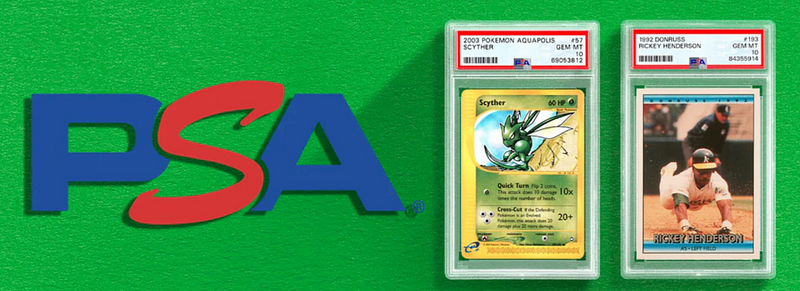
The Trusted Duke: Sportscard Guaranty Corporation (SGC)
SGC, renowned for its distinctive Tuxedo slabs and competitive pricing, offers collectors a reliable alternative in the grading market. With its quick turnaround times — currently one week vs. six weeks for PSA (with turnaround times of a year during COVID)— SGC has built a long-standing reputation for trustworthiness and expertise. Its established reliability in grading vintage collectibles has made it a favored choice among enthusiasts. On February 29, 2024 SGC was acquired by PSA’s parent company, Collectors Universe, further solidifying its place within the industry and expanding its influence. In July 2024, SGC graded over 194,000 cards, reflecting a 105% increase year-over-year.

The Challenger: Beckett Grading Services (BGS)
Beckett Grading Services (BGS) is celebrated for its meticulous grading system and its coveted Black Label designation, which represents the pinnacle of card perfection. BGS employs a tiered grading scale where a BGS 10 Pristine denotes a flawless card, while BGS 9.5 Gem Mint reflects top-tier quality. The inclusion of subgrades — centering, edges, corners, and surface — offers a thorough evaluation, giving collectors and investors an in-depth view of a card’s condition. BGS’s gold label is especially enjoyed by The Hobby. In July 2024, BGS graded over 54,000 cards, reflecting a 4% decrease year-over-year.
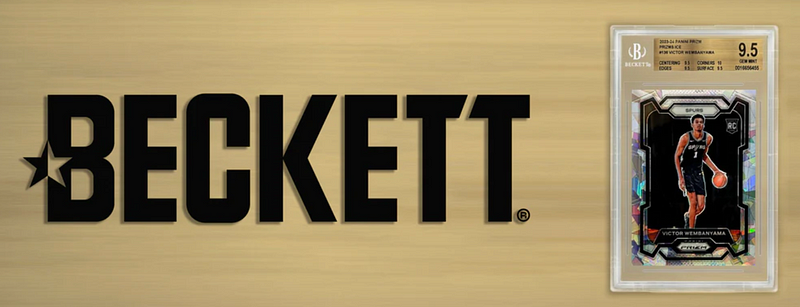
The New Kid: Technical Authentication & Grading (TAG)
TAG distinguishes itself with its unique, modern, transparent slabs and a detailed point system and grade database, enhancing its value to collectors. TAG’s emphasis on transparency and a thorough grading process aims to provide clear, reliable assessments of collectibles. This approach sets it apart in a competitive market, as it strives to offer a fresh perspective on card grading. While I’m still awaiting data on TAG’s performance from Gem Rate, its innovative methods and focus on collector value make it a noteworthy player in the grading industry.
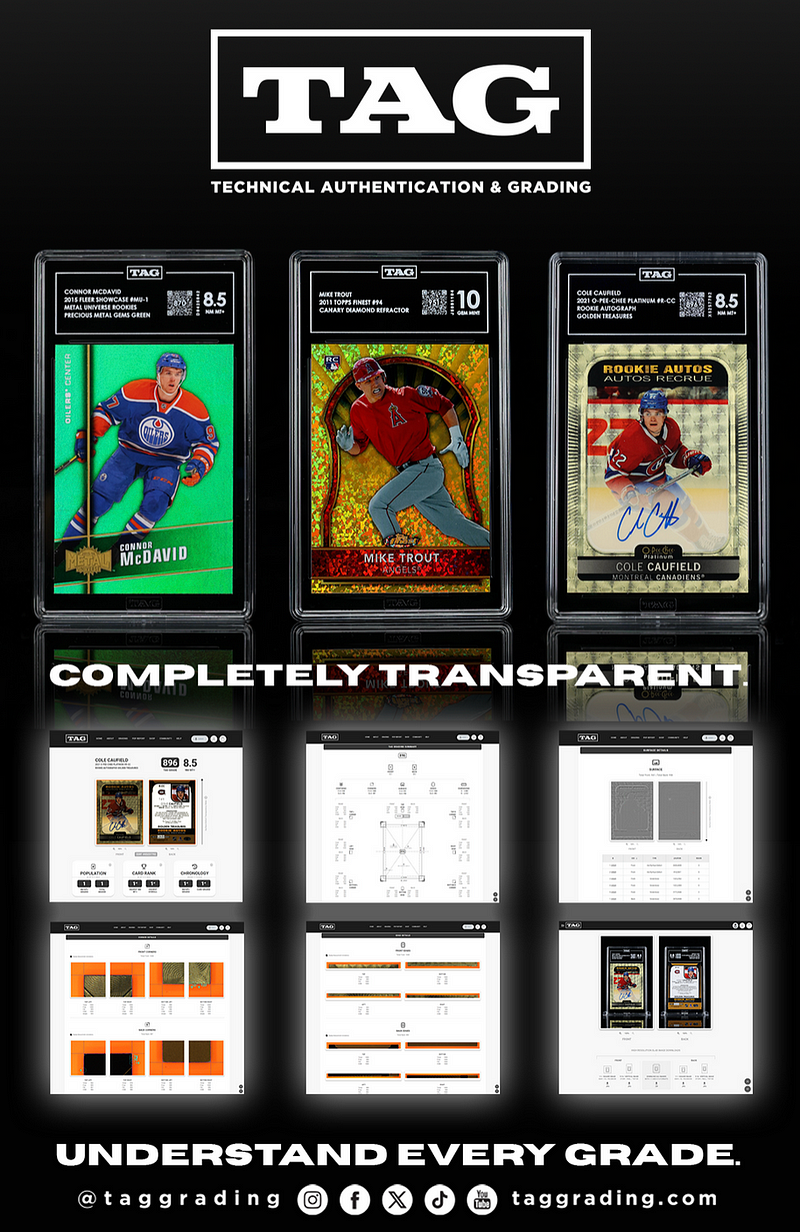
The Kid I Never Met: Certified Guaranty Company (CGC)
CGC emerged as a major player in the collectibles market, carving out a significant niche with its specialized comic book grading services and evaluations of a wide range of other collectibles. Known for its commitment to precision and transparency, CGC employs cutting-edge technology to ensure accurate assessments and maintain a clear, reliable grading process. This dedication has cemented CGC’s strong reputation among collectors and investors. In July 2024, CGC graded over 190,000 cards, reflecting an astounding 172% increase year-over-year.
Recently, PSA has ventured into the comic book grading space, marking some new competition for CGC.
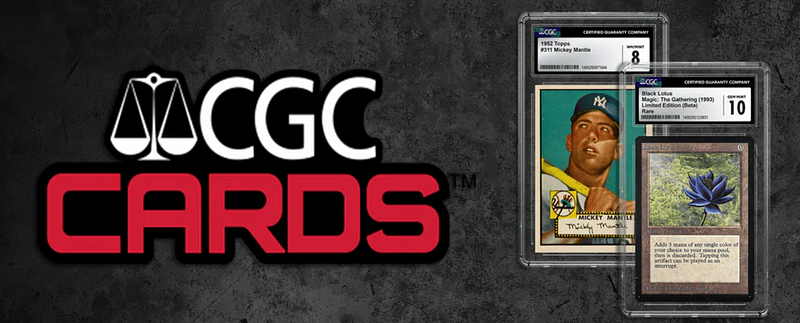
3. Impact of Grading on Card Value
For many members of The Hobby, the volatile and high cost of these collectibles are quite well-known. Keeping track of their collection’s changing value is crucial, and naturally, collectors aim to enhance their cards’ worth while minimizing expenses. As such, collectors look to grading to dramatically increase a trading card’s value, with Gem Mint (10) cards often selling for several times the price of Mint (9).
This disparity is primarily driven by two factors: scarcity and perfection. Scarcity relates to the limited availability of high-grade cards, while perfection underscores the pristine state of a PSA 10 card. By understanding these aspects, along with the distribution of grades and the value of ungraded cards, collectors can better appreciate why higher grades are so highly sought after and valuable.
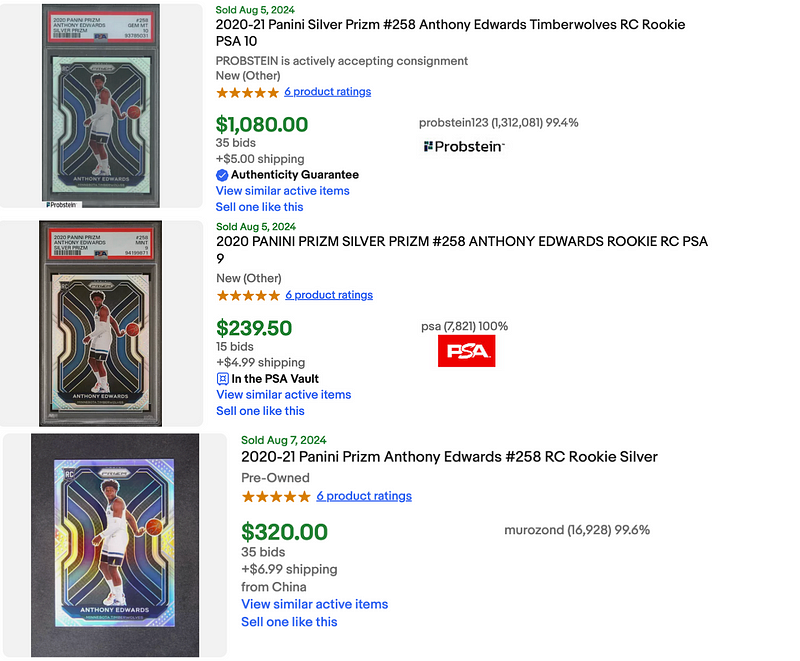
Additionally, value is dependent on who grades the card — although a BGS 9.5 Gem Mint is highly regarded, it generally commands a lower price than a PSA 10 Gem Mint because of preferences in The Hobby. The value of graded cards also hinges on “eye appeal,” or the card’s visual attractiveness.
Market trends indicate that cards, while becoming more sought after due to general demand in The Hobby, are actually decreasing in price due to the increasing “population” of these graded cards. When scarcity goes down, value typically follows.
For those interested in ungraded or “Raw” cards, these are priced similarly to PSA 8s and 9s, as collectors and investors often buy ungraded cards with hopes of achieving the elusive PSA 10.
4. The Grading Process
When you’re ready to submit cards from grading, the submission process begins with carefully preparing and packaging the cards in protective sleeves to prevent damage. On the website or mobile app of the grading service one chooses, collectors complete a submission form detailing the cards and pay any necessary fees before shipping the package to the grading company. Once received, the cards are logged into the system and undergo an initial inspection before graders assess the cards’ condition. After grading, the cards are encapsulated in protective cases with labels showing their grade and are reviewed via a quality control check that ensures accuracy before the graded cards are shipped back to the owner. Depending on which grading service is chosen, the turnaround time ranges from a couple days to a few months.
For resources on ways to ensure safe arrival of your cards at the Grader, follow these tips from Packstacker Crain:
- Protect your cards with PSA’s recommended Card Holder *include an Ultra Pro Premium Penny Sleeve!: Card Saver I
- Seal your Card Saver I
- Use the Ding Defender for safe shipping
- Secure your cards with Painters Tape during shipping
5. Challenges and Controversies
In the global trading card market, several issues can impact community members, particularly regarding grading practices. One major concern is the lack of transparency, exemplified by the fact that PSA, a leading grading service, took over 30 years to introduce Grader Notes, which help collectors understand the rationale behind their card grades. Another issue is market manipulation, with rumors suggesting that cards submitted in person at major events like The National (NSCC) may receive more favorable grades. Furthermore, grading inconsistencies are a known problem; for example, a card initially graded PSA 6 could be reassigned a PSA 10 upon resubmission, highlighting variations in grading standards. Critics also argue that graders might inflate grades for high-demand cards or deflate them to control the scarcity of top-condition cards, a practice known as “pop control.”
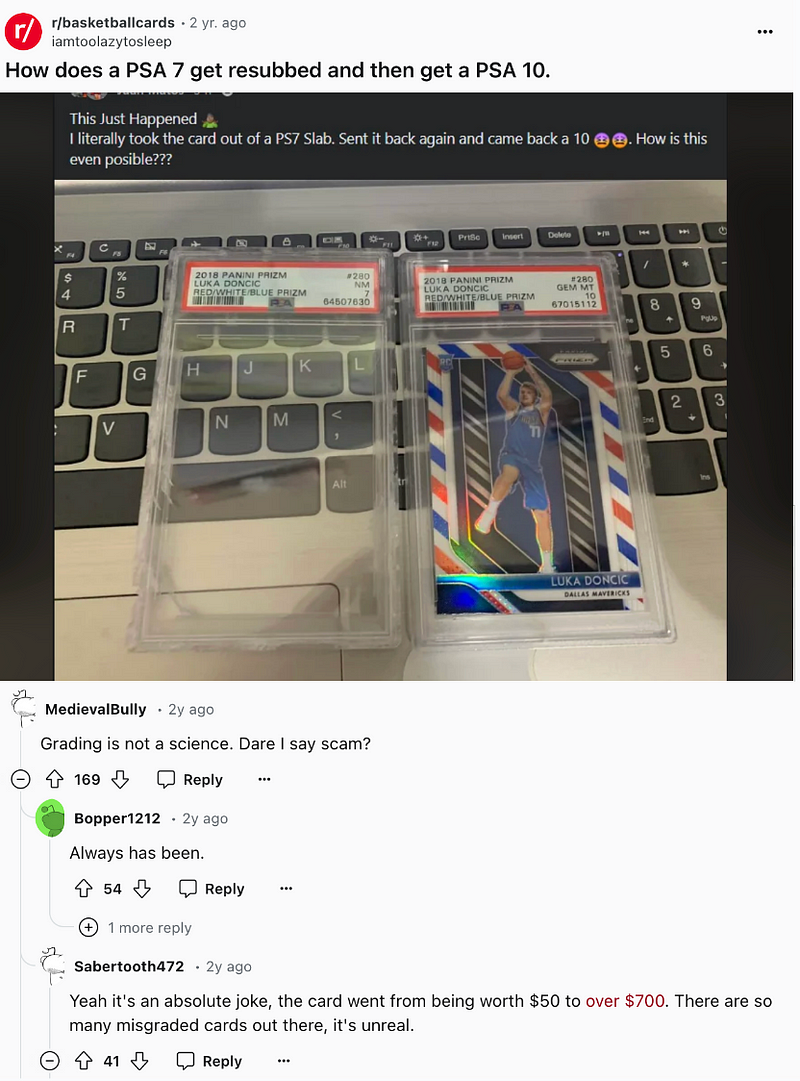
To combat counterfeit cards and inaccurate grades, collectors should verify authenticity by checking the certification numbers on the graded card slab. Additionally, it is crucial to review detailed scans of the graded card to ensure that it matches the advertised condition.
6. Tips for Collectors and Investors
To prepare trading cards for grading, collectors should take several key steps to preserve card condition.
Following the advice of card care experts like Kurt’s Card Care, The Slab Dr., and Mr. Minty who provide valuable guidance and tools for maintaining card quality, begin by handling cards with clean, dry hands and use cotton gloves to avoid fingerprints or oils. Be sure to wipe off any visible fingerprints gently with a soft, non-abrasive cloth and store cards in high-quality Card Savers or similar protective cases.

When it’s time to submit and choose a grading service, consider factors such as the company’s reputation, turnaround time, and costs. Study their communities and understand the user experience before investing further in your inventory.
7. Future of Grading in the Industry
I believe that the future of grading in the trading card industry is poised for significant transformation driven by technological advancements and evolving collector preferences. Innovations like TAG’s transparent grading system, which includes detailed card scans and a nuanced 1,000-point scale, are setting new standards for transparency and accuracy, providing collectors with more comprehensive insights into their cards’ conditions.
Forecasts for growth in the grading sector indicate that collectors will increasingly favor systems that provide greater transparency and detailed feedback. This trend is reflected in PSA’s recent introduction of Grader Notes and the positive reception of TAG’s transparent grading practices.
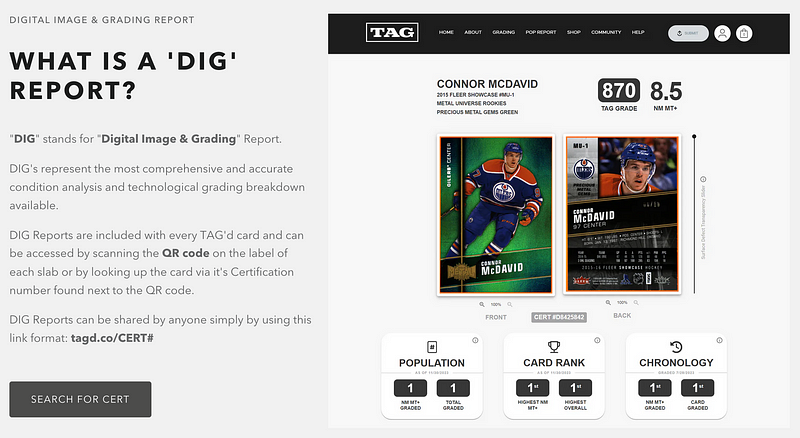
As highlighted on TAG’s website, both provenance and competition enrich the collector’s experience. TAG’s system offers valuable insights, including the card’s population details, its rank among all cards graded by TAG, and its grading timeline relative to other cards. These features add a fun and engaging dimension to the collecting process.
8. A Deep Dive Into Bitcoin Trading Card Grades
With a solid understanding of trading card grading in place, I will now focus on Bitcoin Trading Cards grading. This discussion will center on card populations as verified by PSA’s database, and I’ll follow up with a detailed blog analyzing market values based on the most recent public sales.
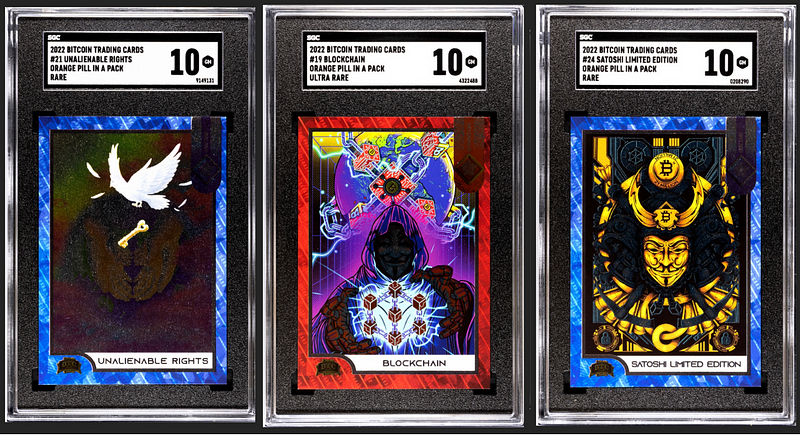
With just over 500 BTCTC cards in the PSA database, I want to start by providing some context. PSA’s database currently lists over 100,000 graded non-sports cards from 2023.
To put this into perspective, PSA has graded 2.2 million Trading Card Game (TCG) cards from 2023 sets. This figure exceeds the total number of 2023 PSA-graded cards in Baseball (958,963), Football (680,555), Basketball (488,362), and Soccer (28,448) combined.
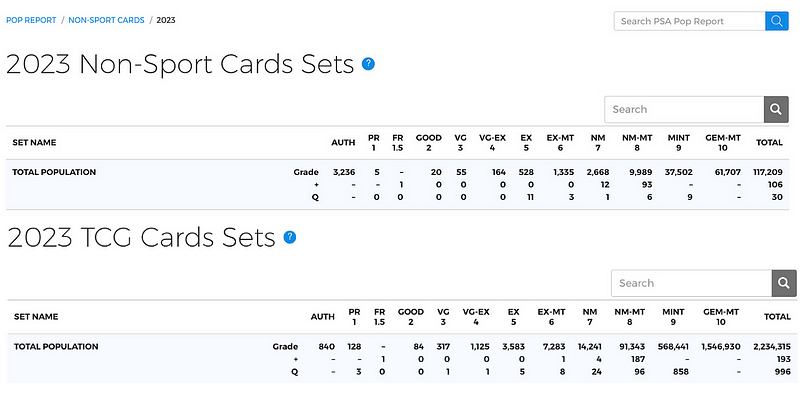
To appreciate the volume of graded cards on the market, it’s apparent that BTCTC distinguishes itself not only for its quality but also for its scarcity. With only two flagship series released so far — 2022 Orange Pill in a Pack (OPP) Series 1 and 2023 OPP Series 2 FUD Busters — and less than a year of PSA grading availability for these sets, the supply is extremely limited. Below, you’ll find the grade distributions for these series, along with a comparative analysis of their grades. Population reports for Series 1 and Series 2 are available here and here, respectively. For additional sets, search “Bitcoin Trading Cards” in the 2023 Non-Sports Database.
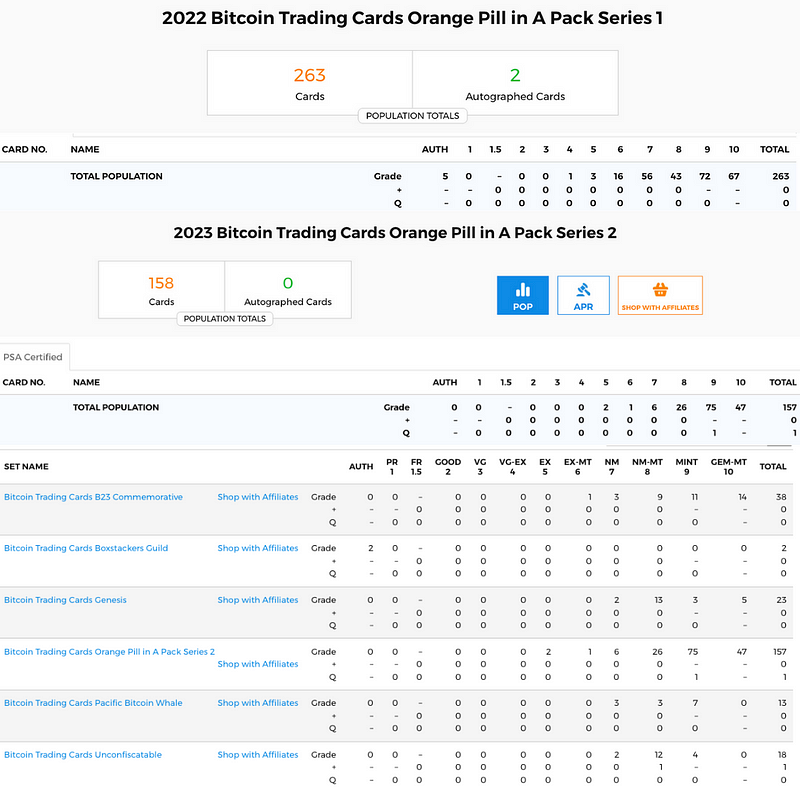
Grading allows us to assess the overall quality of cards from BTCTC sets. As the company refines its process of producing high-quality cards, we can expect improvements over time, as evidenced by the increase in PSA 9 and PSA 10 cards from S1 to S2.
Notably, S1 Orange Pill in a Pack is the only set with a complete set of graded base cards. Out of the 47 unique base cards in the set, only one has achieved a PSA 9 grade — the Bitcoin Card, which has a single copy. This highlights the significant differences in grade distribution between sets, as Series 1 base cards are known for their soft corners and edge wear.

If you’re interested in examining the grade distributions of chase cards in S1 OPP, I’ve included an export from the PSA database below. The data covers 1/1’s, Legendaries (/100), Ultra Rares (/500), and Rares (/1000). Confirming my suspicions, the Satoshi LE Blue Rare (/1000) stands out with nearly four times the number of graded cards compared to the other S1 OPP cards, reflecting a particularly strong love for the card.

So, what are your thoughts about the future of grading in The Hobby? Does the decision to grade your cards, and go with PSA, seem as straightforward as their ads suggest? Let me know on X or Reddit what you think of the future for BTCTC based on its population and grade distribution and what you think of grading!


